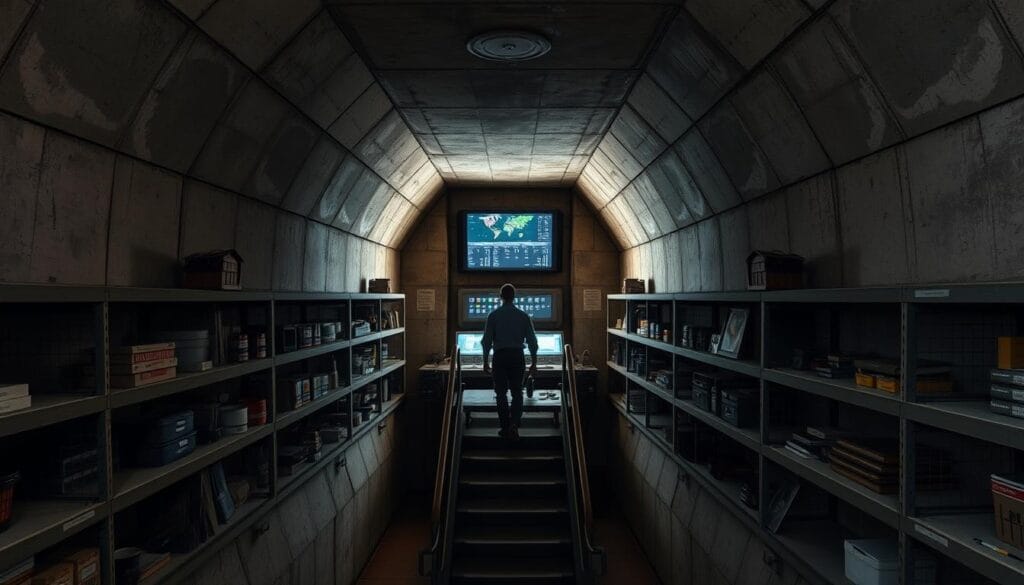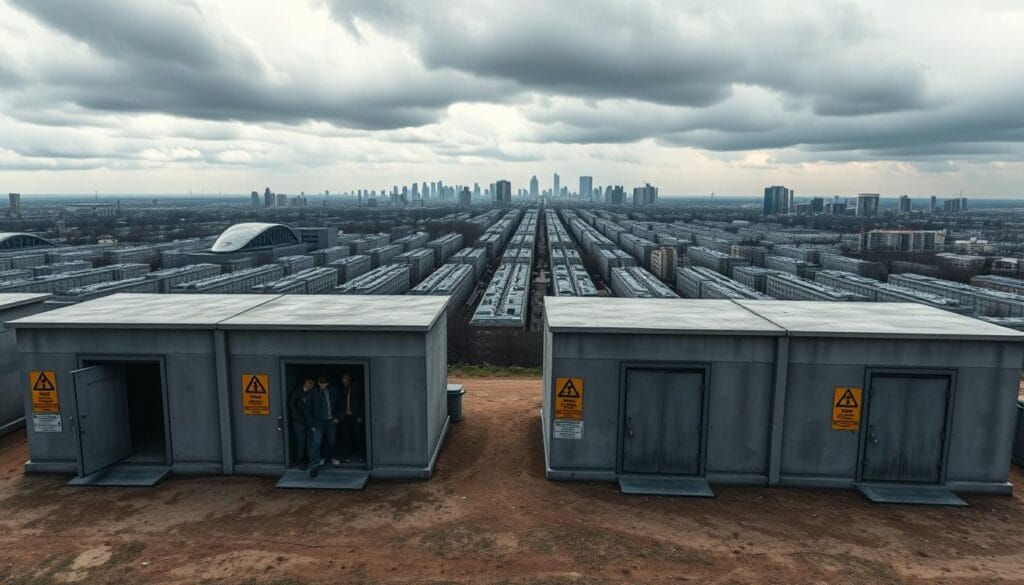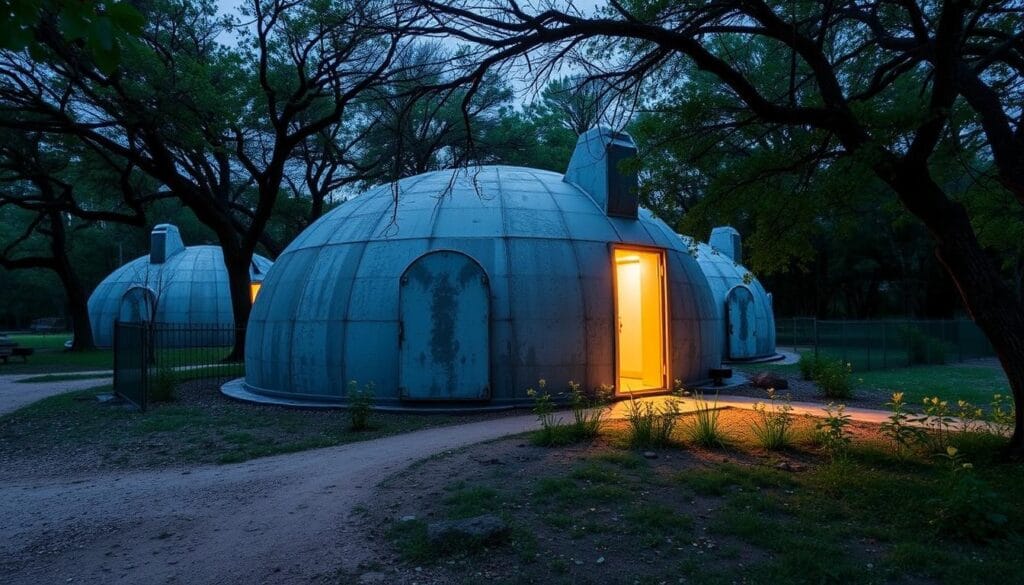Functional Bomb Shelters: What’s Left in the USA?
Explore the state of Functional Bomb Shelters in the USA, their locations, and current status for emergency preparedness and survival.

#image_title
Click to summarize this article.
Functional Bomb Shelters: What’s Left in the USA? Urban areas have grown a lot, making bomb shelters seem old-fashioned. Yet, they are key to staying safe in emergencies. In the U.S., many underground bunkers and shelters are hidden but essential. They show us how to be ready for dangers today.
In places like Arkansas, caves are used as shelters. Sacramento has detailed plans for emergencies. Bomb shelters are valuable, providing safety and supplies. But not all are ready or easy to find.
Functional Bomb Shelters Key Takeaways
- Functional bomb shelters are essential for staying safe.
- Shelters vary by region in the USA.
- Caves in states like Arkansas and Kentucky are used as shelters.
- Less people now care about keeping shelters up to date.
- Good shelters have the right supplies and are strong.
- Big cities like New York and Los Angeles have old shelters.
- We need shelters that are easy to use today.
For a detailed look at fallout shelters by state, check out this resource. If you want to grow a survival garden, learn more here.
Introduction to Fallout Shelters
Nuclear fallout shelters are key for emergency preparedness. They protect people from radioactive fallout. These shelters are safe places to wait out dangerous times after a nuclear blast.
During the Cold War, building these shelters became more critical. But they are also important today.
Shelters have undergone significant changes over time. At first, they were simple and offered little protection. Now, they have access to advanced technology, including air filters and food.
These shelters help people survive for a long time. They are made to keep people safe and healthy in bad conditions.
The main goal of nuclear fallout shelters is the same. They offer a safe place and help reduce risks from radioactive fallout. As people learn more about emergency preparedness, they want better shelters. They want shelters that can protect more people from nuclear threats.
History of Bomb Shelters in the USA
The USA’s bomb shelters have changed a lot over time. This change came from big events and shifts in world politics. It’s a story that shows how we got to where we are today.
The Cold War Era
During the Cold War, people were terrified of nuclear attacks. So, many bomb shelters were built in the USA. Families built their shelters, and the government built big ones too.
This time was all about keeping people safe from harm. It was a big effort to protect everyone.
Post-Cold War Developments
After the Cold War ended, the need for bomb shelters was no longer as urgent. Many shelters were left to decay or were used for other things. The government reduced its spending on keeping people safe.
Modern-Day Concerns
Nowadays, the world is again worried about nuclear threats. This has made people want to build bomb shelters again. There’s a big push for civil defense and getting ready for emergencies.
What Makes a Good Bomb Shelter?
Choosing the best bomb shelters involves looking at many important factors. A good shelter protects and gives peace of mind to those inside.
Structural Requirements
A key part of a secure underground shelter is its structural integrity. It should be made with strong materials like reinforced concrete or steel. This helps it stand up to blasts.
Good shelters also have strong walls and ceilings. These can handle pressure and debris. Keeping the shelter in good shape is essential.
Essential Supplies and Amenities
Having the right supplies is key in a bomb shelter. You need non-perishable food, water, medical supplies, and hygiene products. These help you survive for a long time.
Additionally, having essential amenities such as air systems, toilets, and communication methods to the outside world is necessary. These things help keep everyone safe and comfortable.
Location and Accessibility
The location where a bomb shelter is built is crucial. It should be in a quiet area to avoid danger. It’s also essential that it’s easy to get to.
Consider where it is, such as near fault lines or flood areas. For more tips on getting ready for emergencies, check out this helpful guide.
Public vs. Private Bomb Shelters
Public and private bomb shelters have their own good and bad points. Knowing the differences helps people choose the best for their safety plans.
Public fallout shelters are easily accessible to many. But, they might be hard to reach because of where they are. They are paid for by the government and kept in good shape. These shelters can hold many families, which is key in big emergencies.
Private survival shelters are designed for a small group of people. They cost a lot to build and keep up. But, you can make them just how you like. You can add what you need to make it more comfortable in emergencies.
| Parameter | Public Fallout Shelters | Private Survival Shelters |
|---|---|---|
| Accessibility | High but potentially crowded | Limited to owners and invitees |
| Maintenance | Government-maintained | Owner-maintained |
| Cost | Funded by taxes | Personal investment |
| Customization | Standard amenities | Highly customizable |
| Capacity | Large groups | Small, individual groups |
How easy it is to get to a shelter is very important. Those who can afford private shelters might be better off. But, public shelters are key for helping whole communities in emergencies.
Current State of Public Bomb Shelters in the USA
In recent years, people have forgotten about public bomb shelters in the USA. But they are very important. Even though new dangers have come up, we need these shelters more than ever. The state of these shelters shows how disaster plans have changed.
Remaining Functional Public Bomb Shelters
There are not many public bomb shelters left in the USA. Most of them were built during the Cold War. Some are in good shape, but others are not.
Government Policies and Support
Today, government policies help keep these shelters running. The Federal Emergency Management Agency (FEMA) works with local groups to fix and update shelters. They want to make sure everyone has a safe place to go in emergencies.
| State | Number of Functional Shelters | Government Support |
|---|---|---|
| California | 50 | High |
| Texas | 35 | Medium |
| New York | 20 | Low |
Functional Bomb Shelters: What’s Left in the USA?
Knowing where bomb shelters are in the USA is key to safety. The number of shelters varies by region. This depends on history, politics, and geography.
Regional Availability
Shelters are not spread out evenly. Big cities like New York, Los Angeles, and Washington have many. But, rural areas often have few or none.
Notable Locations
Some shelters are famous for their history and design. The Greenbrier in West Virginia has a secret bunker for Congress. Cheyenne Mountain in Colorado is a key spot for NORAD.
The Greenbrier Resort has a hidden shelter too. It’s a great example of a well-prepared shelter.
| Region | Notable Locations |
|---|---|
| East Coast | Greenbrier (WV), Raven Rock Mountain Complex (PA) |
| West Coast | Los Angeles Emergency Operations Center (CA) |
| Midwest | SubTropolis (MO) |
| Mountain Region | Cheyenne Mountain Complex (CO) |
| South | Houston Emergency Command Center (TX) |
Looking at where shelters are helps us see what’s missing. It shows we need to plan and invest more in shelters.
Interactive Maps of Bomb Shelters
In today’s world, knowing where bomb shelters are can give you peace of mind. Interactive bomb shelter maps help you find shelters near you. They show updates and details about each shelter.
State-by-State Maps
State-by-state shelter location maps make finding safe places easier. By clicking on your state, you can see shelters nearby. This makes it easy to navigate bomb shelter maps and find what you need.
| State | Notable Locations | Unique Features |
|---|---|---|
| Virginia | Mount Weather Emergency Operations Center | Fully operational for government officials |
| Colorado | Cheyenne Mountain Complex | Military base with extensive security and water supply |
| New York | Fort Hamilton | Active US military base with an underground facility |
How to Use the Maps
Learning how to use these maps is key. Start by typing in your location or picking your state. The maps show pins for shelters. Clicking on a pin provides information about the shelter, including its size and safety features.
Interactive bomb shelter maps are great for getting ready for emergencies. They help you find and use shelters quickly and safely.
Examples of Private Fallout Shelters
In recent years, more people want private bomb shelters for safety during nuclear emergencies. Personal survival shelters come in many designs and meet different needs. Let’s look at some examples.
One great example is the modern underground bunker. It has advanced engineering and luxury. These shelters can handle big blasts and radiation, keeping families safe. They have air filters, power, and water systems for long stays.
Another cool example is the shelter made from a shipping container. These shelters use strong, weather-proof containers. They are easy to move, affordable, and simple to set up.
| Type | Features | Advantages |
|---|---|---|
| Underground Bunker | Air filtration, power generators, water purification | High blast resistance, long-term accommodation, luxurious amenities |
| Shipping Container Shelter | Sturdy structure, mobility, and affordability | Easy installation, cost-effective, versatile |
| Backyard Bomb Shelter | Close proximity, rapid access, convenient storage | Immediate availability, easy to stock and maintain |
The demand for personal survival shelters is growing. People want safe and comfortable places for emergencies. By looking at different shelters, you can choose the best one for you.
Preparing Your Bomb Shelter
Building your bomb shelter can give you peace of mind. You can start from scratch or use an existing place. It’s important to know the steps and what to stock up on for safety.
Building from Scratch
Starting from the beginning requires careful planning and adherence to the rules. Consider the depth of the shelter and the materials to use. Also, make sure it has good air flow.
By doing things right, you can make a safe place for emergencies. Look at FEMA’s Family Preparedness Guide for help.
Repurposing Existing Structures
Turning old buildings into shelters is a smart move. Basements and garages are good choices because they’re already underground. Make sure to make it strong and safe.
Seal it well and add what you need for emergencies. This way, any underground room can become a safe place.
Stocking Up on Essentials
Having the right stuff is key. You’ll need food, water, medical supplies, and more. Think about adding solar panels and backup power, too.
Get tools that can be used in many ways. Make sure you have enough for your family to last a long time.
Nuclear Fallout Shelters vs. Other Types of Emergency Shelters
When comparing fallout shelters with other types of emergency shelters, it’s key to know what each protects against. Fallout shelters are made to handle the harsh effects of a nuclear blast. They offer a safe place in such dangerous times.
Unlike storm shelters, which are built to withstand strong winds, fallout shelters need special materials and air filters. These help keep out harmful radiation.
Comparing fallout shelters and flood shelters shows a big difference. Flood shelters are built high up and sealed tightly to keep out water. Fallout shelters, on the other hand, are underground. They protect against radiation and blast pressure.
To show how shelter effectiveness works, let’s look at a table:
| Emergency Shelter Type | Primary Threats | Key Features |
|---|---|---|
| Nuclear Fallout Shelter | Radiation, Blast Pressure | Reinforced Construction, Ventilation Systems |
| Storm Shelter | High Wind Events | Sturdy Frame, Secure Anchoring |
| Flood Shelter | Flooding | Elevated Structure, Waterproofing |
Each shelter type protects against its dangers. But, fallout shelters stand out. They’re built strong and have special features. This makes them crucial for preparing for many disasters.
Case Studies: Notable Bomb Shelters in the USA
Bomb shelters are essential for safety. Places like The Greenbriar Resort, Project Greek Island, and Cheyenne Mountain Complex show how they helped in the past. They kept important people safe during hard times.
The Greenbriar Resort
The Greenbriar Resort in West Virginia is famous. It has a secret bunker for Congress in a nuclear attack. It was hidden until 1992, when The Washington Post found out.
Now, it shows how serious people were about safety back then.
Project Greek Island
Project Greek Island is a big secret bunker. It’s in the Allegheny Mountains. It was meant for government officials to stay safe.
Even though it’s not used anymore, it’s remembered for its role in the Cold War.
Cheyenne Mountain Complex
The Cheyenne Mountain Complex in Colorado is powerful. It’s built into a mountain to protect against big dangers. It’s where NORAD works, showing its importance in defense.
The Importance of Emergency Preparedness
Knowing the value of emergency preparedness is key to keeping our communities safe. We must be ready for disasters, like nuclear threats. This means understanding disaster readiness and having good shelters.
Learning survival skills is very important. We need to prepare an emergency kit and a solid plan. Essential items include water, non-perishable food, medicine, and a radio that works without power.
Disasters like earthquakes, hurricanes, and fires, as well as threats from people or computers, require us to know what to do. Every family should know how to act in emergencies. This includes notifying authorities, receiving alerts, and learning how to exit quickly.
The Department of Defense provides extensive support for staying ready. This is for Service Members, DoD workers, contractors, and their families.
Being ready all the time means updating plans and learning new survival skills. By being proactive, we can all be better prepared for disasters. And make sure our shelters can keep us safe.
Challenges Facing Bomb Shelters Today
Bomb shelters today face many problems. These issues include financial problems, maintaining their health, and insufficient awareness among the public. These problems make it hard for many places to be ready for emergencies.
Lack of Funding
Money is a big problem for bomb shelters. Even though attacks pose a significant threat, not enough money is allocated to build and maintain safe shelters. A bunker can cost about $500,000, making it hard to find enough money.
The market for bomb shelters is growing. However, it’s challenging to secure sufficient funds to meet this demand.
Public Awareness
Not enough people know about bomb shelters. This makes it hard to be ready for emergencies. It’s important to educate more people about shelters and their proper use.
Maintenance and Supplies
Keeping shelters in good shape is hard. It costs a lot to keep them ready to use at any time. FEMA says even basements need to be kept up to protect from harmful fallout.
| Challenges | Impacts | Potential Solutions |
|---|---|---|
| Shelter Funding Issues | Limited availability of functional shelters | Increased government and private investments |
| Public Knowledge of Shelters | Low utilization and awareness | Public education campaigns and initiatives |
| Shelter Maintenance Challenges | Unreliable emergency preparedness | Regular maintenance schedules and supply check-ups |
Functional Bomb Shelters Conclusion
Bomb shelters in the USA have a long history. They are key to our safety plans. From old Cold War shelters to new ones, we keep working to stay safe.
However, there are challenges ahead, such as financial issues and getting people to care. Yet, their role is significant.
We see the need for both public and private shelters. Maps and studies help us understand what we have. They show us what we need for safety.
We must keep working together to make shelters better. As threats change, so must our shelters. This shows how vital shelters are for our safety.
Functional Bomb Shelters FAQ
What is a functional bomb shelter?
A bomb shelter is a safe place. It protects people from explosions and nuclear fallout. It’s built strong, has what you need, and is in a good spot.
What are fallout shelters?
Fallout shelters keep people safe from radioactive dust after a nuclear blast. They protect from the first blast and radiation for a long time.
How did bomb shelters evolve during the Cold War?
During the Cold War, bomb shelters were critical. People built their own and governments built public ones. Everyone was scared of nuclear war.
What happened to bomb shelters after the Cold War?
After the Cold War, people didn’t worry as much about nuclear war. So, many shelters were forgotten and got old.
Why is there a resurgence of interest in bomb shelters today?
Today, we worry about nuclear war again. This makes people want to have bomb shelters as a way to stay safe.
What are the essential features of an adequate bomb shelter?
A good bomb shelter is strong and has food, water, and air. It’s easy to get to and has air filters.
What’s the difference between public and private bomb shelters?
Public shelters are for everyone and are run by the government. Private ones are for the owner. Public ones are more common but might not be as good. Private ones are better but harder to find.
Are there any functional public bomb shelters in the USA?
Yes, some public bomb shelters in the USA are working. But, they vary by area and might not be perfect.
Does the government support public bomb shelters?
The government used to provide significant support for public bomb shelters. Now, they don’t help as much. But, some local governments keep them ready for emergencies.
How can I find a bomb shelter near me?
You can use online maps to find bomb shelters. These maps are on government and emergency websites. They show where shelters are and how to get there.
What are the advantages of private fallout shelters?
Private shelters are custom-made and well-kept. They belong to the owner and can have special features. They’re ready for you anytime.
How can I prepare my bomb shelter?
You can make a bomb shelter from scratch or use a basement. It needs to be strong, have air, and have supplies like food and water.
What are the different types of emergency shelters?
There are many shelters like those for nuclear fallout, storms, and doomsday. Each protects against different dangers.
Can you provide examples of notable bomb shelters in the USA?
In the USA, there’s the Greenbriar Resort with a secret bunker. There’s also Project Greek Island and the Cheyenne Mountain Complex. These are all designed to survive nuclear attacks.
What are the main challenges facing bomb shelters today?
Today, bomb shelters face many problems. There’s not enough money for upkeep, not enough people know about them, and it’s hard to keep them ready for emergencies.










